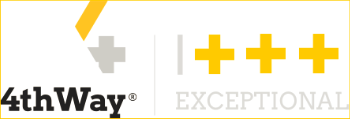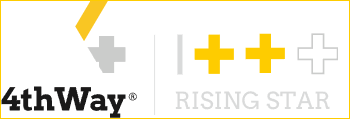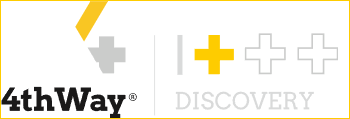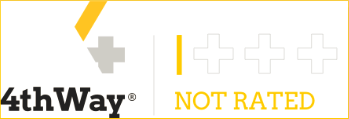Who created the 4thWay PLUS Ratings and 4thWay Risk Scores?
What does each 4thWay PLUS Rating mean?
What do each of the 4thWay Risk Scores mean?
What is the methodology for awarding – or withholding – 4thWay PLUS Ratings?
What is the methodology for awarding – or withholding – 4thWay Risk Scores?
What lenders need to do.
Who created the 4thWay PLUS Ratings and 4thWay Risk Scores?
The 4thWay PLUS Ratings and 4thWay Risk Scores were created by a senior credit specialist, a senior quantitative risk modeller (i.e. someone who helps banks improve their lending) and experienced investors.
What does each 4thWay PLUS Rating mean?
 The top rating of three PLUSes – Exceptional – is based on calculated results during a severe recession similar to the Great Recession, combined with a deep property crash where distressed sale prices can drop 55%.
The top rating of three PLUSes – Exceptional – is based on calculated results during a severe recession similar to the Great Recession, combined with a deep property crash where distressed sale prices can drop 55%.
Major recessions like this are few and far between. We never know when these will hit in advance, but in Basel they are called one-in-100-year events.
If you lend across a basket of +++ Rated lending accounts, we expect the interest most lenders earn will more than cover losses, if you suffer any, by the time all your loans are repaid. In the event the loans are typically under one year, we assume you lend for at least two years.
We can’t overstate this! The ratings assume you sensibly do all the following:
- Lend across many loans.
- Lend in six or more rated lending accounts.
- Lend for at least two years and until borrowers repay in full, i.e. you don’t sell your loans early.
 ++ 4thWay Excellent PLUS Rated lending accounts are the same as 3/3 “Exceptional”, except that your coverage against losses in a basket of these accounts might not always quite hold out in a severe recession and property crash. But we strongly expect that they would in a moderate recession and property crash.
++ 4thWay Excellent PLUS Rated lending accounts are the same as 3/3 “Exceptional”, except that your coverage against losses in a basket of these accounts might not always quite hold out in a severe recession and property crash. But we strongly expect that they would in a moderate recession and property crash.
Roughly speaking, bad debts could be around two-thirds as much as during the severe recession – on average, so this is still fantastic cover.
Lending and re-lending your money before, through and after any recession should greatly reduce the risk of losses and improve your returns.
 A lending accounts with the ++ 4thWay Rising Star PLUS Rating is well on course to earn the top 3/3 PLUS “Exceptional” Rating, but its history is not deep enough and mature enough yet for all 4thWay’s banking models and tests to be significant.
A lending accounts with the ++ 4thWay Rising Star PLUS Rating is well on course to earn the top 3/3 PLUS “Exceptional” Rating, but its history is not deep enough and mature enough yet for all 4thWay’s banking models and tests to be significant.
 ++ 4thWay Hidden Gem PLUS Rated lending accounts have passed the same tests as the 3/3 “Exceptional” rated ones. They show fantastic protection through severe recessions and property crashes.
++ 4thWay Hidden Gem PLUS Rated lending accounts have passed the same tests as the 3/3 “Exceptional” rated ones. They show fantastic protection through severe recessions and property crashes.
These lending accounts have dropped a rating point, because the detailed data on every loan that we receive is missing some elements that reduce certainty a little bit. Most typically, this means that it’s not easy to rule out that there are some unseen bad debts.
Some ++ Rated accounts offer more opportunities to diversify and they might sometimes offer significantly different kinds of lending. That gives you another form of protection, because typically, while some types of borrowers go through a bad patch, other types will be doing just fine. In addition, you can potentially earn higher interest rates with ++ Rated accounts.

Lend across a basket of + 4thWay Fair Rated lending accounts and we expect the interest most lenders earn will cover the losses, if any, during normal conditions or during a small blip in the economy and property market, by the time your loans are repaid or within two years of re-lending if the loans are very short term.
While lenders are expected to make money most of the time, losses are possible for the average lender in a minor or major recession.
Most likely, at least a proportion of lending accounts with a single + Rating will also do fine in more difficult times as well. If not, you’ll need to consider re-lending for longer through the good times.

+ 4thWay Discovery PLUS Rated lending accounts don’t provide sufficient data and information for us to conduct our tests, but aggregated statistics and information indicate it would earn a 2/3 Excellent or 3/3 Exceptional Rating if full data was provided.
Alternatively, lending accounts earn 1/3 Discovery if they would have earned 2/3 Excellent, were it not for a few small gaps in the full data and information provided.
 If a peer-to-peer lending account is Not Rated, it means it hasn’t passed any of our tests.
If a peer-to-peer lending account is Not Rated, it means it hasn’t passed any of our tests.
Perhaps the peer-to-peer lending website doesn’t have a long enough history to be rated using the Basel method or it hasn’t provided us with the data we need. Alternatively, its results have been poor, leading us to calculate that it could lead to losses for the average lender even during normal times or just a small blip.
Whatever the reason that an account is unrated, some of these products will end up as disappointments for lenders.
All peer-to-peer lending providers require investigation before you lend, but we believe that unrated sites require a greater level of attention and alertness from lenders.
What do each of the 4thWay Risk Scores mean?
Unlike the 4thWay PLUS Ratings, the 4thWay Risk Scores don’t factor in the interest you might earn.
The 4thWay Risk Scores look solely at the risk side. They take into account the scale of potential losses from bad debts in a given peer-to-peer lending account in a very severe recession or property crash.
As with the 4thWay PLUS Ratings, the 4thWay Risk Scores assume that you spread your money across lots of loans, using multiple peer-to-peer lending providers to do so.
Usually, the higher the 4thWay Risk Score, the greater the range of results from lender to lender, especially in a major downturn.
The 4thWay Risk Scores are indicators of average losses from bad debts, not guarantees or promises, so please don’t use them without supplementary research.
| 4thWay Risk Score |
Calculated result |
| 1 |
For savings accounts only. P2P lending can’t score 1. |
| 2 |
No expected losses. Reserve funds (or other defences) are not depleted. |
| 3 |
Loss before interest earned of up to 2.5%. |
| 4 |
Loss before interest earned of up to 5%. |
| 5 |
Loss before interest earned of up to 10%. |
| 6 |
Loss before interest earned of up to 15%. |
| 7 |
Loss before interest earned of up to 20%. |
| 8 |
Loss before interest earned of up to 30% (stock market 1). |
| 9 |
Loss before interest earned of up to 40% (stock market 2). |
| 10 |
Loss before interest earned of 40%+ (stock market 3). |
| N/A |
Not enough data or history. |
These are lenders’ calculated average results; some lenders can achieve worse results through bad luck. The best way to reduce bad luck is to lend across lots of loans. Often, the higher the 4thWay Risk Score, the more loans you need to spread across.
What is the methodology for awarding – or withholding – 4thWay PLUS Ratings?
1. Gather background information
Firstly, we need to establish a certain level of openness, acccess and transparency from the P2P lending provider, with a low proportion of identifiable errors in its data.
And we look to see that its got the appropriate permission from its regulator and, where necessary, engage local lawyers to look into the legal structure of loans. Loans need to be direct lending, so that the borrowers still owe you even in the event that the P2P provider collapses.
Most of this will not be used in the rating itself, but without it we do not feel comfortable going on to assess them for a rating.
2. Look for obvious signs of imminent collapse
The 4thWay PLUS Ratings assess the interest rates on one side. On the other side, it considers the main risk to lenders, which is the risk that bad debts get too large.
What the 4thWay PLUS Ratings don’t do is take into account other types of risks, so you need to read up and research more on any given offer.
One of the risks that bothers some individuals doing peer-to-peer lending (probably too much) is the risk of a legitimate P2P lending website going out of business.
While we don’t take that risk into account in the actual rating calculation, if we spot a very obvious, very imminent collapse on the cards, we will remove its rating and send out an email alert to our newsletter subscribers.
The 4thWay PLUS Ratings are not an indicator that a P2P lending site is financially strong, or that it won’t have to close down and enact its obligatory back-up plans to wind down existing loans smoothly.
3. Collect enough data to work with
To conduct the Basel assessments for a 2/3 or 3/3 4thWay PLUS Rating, we need to regularly receive a log of every loan that has ever been approved, along with key details of those loans, including, among many other things, the current status of the loan and the value of any security.
We also need details of any additional protections that the provider offers, such as the size of any reserve fund it has segregated for the exclusive purpose of covering expected bad debts on lenders’ behalf.
4. Check that the history is substantial enough
Depending on the type of lending, we require a minimum number of loans that have been around for a minimum length of time.
For lending to buy-to-let landlords the minimum number of loans required is a lot smaller than the history needed for personal loans, for example. We apply this standard equally to all P2P lending websites.
5. Add on standard penalties
We then assess the quality of the information and the size of the history. If a P2P lending product has only just passed step four, we deduct standard penalties until the data quality or the length and depth of its loan book increases further.
We also look for specific warning signs of interest to professional bank risk modellers, and penalise if we find them. For example, one of the key ones is whether the loan book is heterogeneous and monotonous – a rather pompous piece of specialist banking jargon to mean that the loans look consistent and that the risks move smoothly in line with the interest rates charged to borrowers.
Another example practice we look for is regrading, e.g. when a platform changes a borrower from A+ to C on its own rating scale. This could reveal the provider is poor at assessing borrowers in advance.
6. Add on non-standard penalties
Sometimes individual loan books or peer-to-peer lending providers present us with unique problems, such as when they don’t give us enough information to know how their individual loans are split between different lending accounts.
In those cases, we always take a very cautious approach to tailoring the assessment, so that we assume the worst imaginable split for each lending account. If even a cautious assessment is not possible, we simply refuse to offer a rating at all.
We have a fixed procedure for how we go about this, so that we maintain consistency.
7. At last, we begin the detailed assessment
At this stage, we’re now ready to look into the meat of the matter.
We look at how many loans are late or that have gone bad. Importantly, we look at the types of loans on offer. We look at the size of the security compared to the loan size. We factor in any reserve funds or other defences. And we look at the interest rates lenders are offered.
If there’s enough history and detailed information, we will look at the P2P lending site’s performance in recovering bad debts. Otherwise we just assume poor results compared to typical banks.
8. We conduct severe stress tests for disaster scenarios
Based on all the factors in step seven and the penalties in steps five and six, we then do the Basel calculations that banks are required to do across the globe to see whether there is a serious risk of losing money due to bad debts.
Unlike the banks, we stress test to see the risk of losses in what we call a 1-in-100-year recession, so a severe recession. Plus, for property lending, we assume distressed sale prices during a property crash of 55% below the initial property valuation.
We then see if it earns enough interest and has enough other defences to prevent losses to the average lender.
If the P2P lending account passes those tests, it earns the top 4thWay PLUS Rating. If it passes softened tests, it can earn one of the other two PLUS Ratings. Poor P2P lending sites can’t earn a rating.
Throughout, we make very cautious assumptions. For example, we assume that all late loans will turn into bad debts. Another example: we assume that any security is worthless if it’s not properly valued and no decent legal claim is put on it in the contracts with the borrowers.
We assume one recession and one property crash
When loans are hit by a recession and property crash, the negative impact isn’t instantaneous and it’s spread out over the following years.
4thWay only factor for loans being hit by one severe recession and one major property crash, although to us this does include a double-dip recession/crash from the same cause, since that’s really one event.
If a second, separate downturn event was to occur in quick succession, that’s not factored into our calculations. This is such a rarity, because usually a recession/crash causes all the weakest problems in an economy to come out, making a second, unrelated downturn less likely, while also making the remaining loans stronger.
New loans also tend to come with lower risks after a downturn begins, because most P2P lending providers and banks ensure their standards are especially strict in these times. This is so that they can ward off any weak borrowers who might be facing continued suffering from the downturn. This further reduces the risks if one crash was immediately followed by another with a completely different cause.
9. Monitor results and look for improvements to our methodology
We don’t stop there. We continually monitor how we can improve the methodology. We make a lot of minor improvements throughout the year and every year or two we do a major upgrade.
What is the methodology for awarding – or withholding – 4thWay Risk Scores?
The 4thWay Risk Scores are based on the same methodology as for the 4thWay PLUS Ratings, as outlined above.
The difference is that the assessment excludes the interest earned and just looks at the results in the toughest disaster scenario: the severe recession and major property crash.
What lenders need to do
It’s an assumption on our part that you’ll sensibly spread your money across lots of loans and different P2P lending providers. And we assume you’ll keep lending until the loans are repaid, even if there’s a recession or other disaster. Many of you won’t, but that’s your decision to cut your good, interest-paying loans at that time, leaving you only with your bad ones. (If you’re able to sell at all, which gets harder in downturns.)
That is the basis upon which the 4thWay PLUS Ratings and 4thWay Risk Scores are made.
Please take the time to learn more and research more, understanding the investment opportunities to an ever greater extent, so that you can refine your choices and feel more confident, especially during recessions.
It is during downturns that those lending with little knowledge then go on to panic, try to sell their loans early, and find the only way to do so is to sell for a cut price. Those buying for a cut price are laughing. Those who confidently held on throughout will usually come out just fine.
Where next?
Please see the PLUS Ratings and Risk Scores in our impartial peer-to-peer lending comparison tables.
Independent opinion: 4thWay will help you to identify your options and narrow down your choices, but the decision is yours. We're responsible for the accuracy and quality of the information we provide, but not for any decision you make based on it. The material is for general information and education purposes only.
We are not financial, legal or tax advisors, which means that we don't offer advice or recommendations based on your circumstances and goals.
The opinions expressed are those of the author(s) and not held by 4thWay. 4thWay is not regulated by ESMA or any of the domestic financial regulators in Europe. All the specialists and researchers who conduct research and write articles for 4thWay are subject to 4thWay's Editorial Code of Practice. For more, please see 4thWay's terms and conditions.
This page was adapted from our UK website. The original is here.


 ++
++ A lending accounts with the ++ 4thWay Rising Star PLUS Rating is well on course to earn the top 3/3 PLUS “Exceptional” Rating, but its history is not deep enough and mature enough yet for all 4thWay’s banking models and tests to be significant.
A lending accounts with the ++ 4thWay Rising Star PLUS Rating is well on course to earn the top 3/3 PLUS “Exceptional” Rating, but its history is not deep enough and mature enough yet for all 4thWay’s banking models and tests to be significant.


 If a peer-to-peer lending account is Not Rated, it means it hasn’t passed any of our tests.
If a peer-to-peer lending account is Not Rated, it means it hasn’t passed any of our tests.
